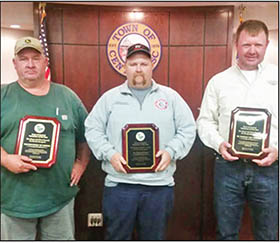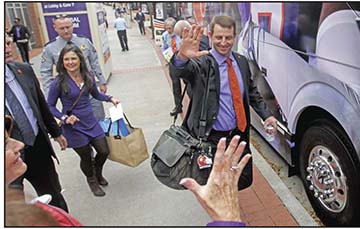Monthly Archives: December 2016
School district gets good news on annual audit
By Greg Oliver
Courtesy The Journal
goliver@upstatetoday.com
PICKENS COUNTY — The School District of Pickens County has received an “unmodified opinion” on the 2015-16 audit presented to school board trustees at a recent meeting.
“The unmodified opinion by the auditing firm of Greene, Finney and Horton, CPAs, is the best opinion a school district can earn,” school district spokesman John Eby said.
During its presentation, the Greenville firm told the board that the general fund balance as of June 30 was $24.95 million — an increase of $2.6 million for fiscal year 2016. The unassigned fund balance was $23.2 million as of June 30, and the firm added that the fund balance represents 20.2 percent of 2017 budgeted expenditures.
Greene, Finney and Horton representatives added that a strong fund balance is very important for cash flow through the end of the calendar year until tax revenues are received, is needed due to economic times and uncertainty when it comes to state finances, allows for emergencies and unanticipated events and provides potential for better interest rates when the district issues debt.
When it comes to general fund revenues, the firm told trustees the district’s $105.6 million was $2.05 million more than the previous year.
The increase was attributed to a $1.3 million increase in state revenues due to a hike in EFA and state allocations for fringe benefits and reimbursement for property tax relief. In addition, local revenues increased $700,000 due to an increase in property tax collections that totaled $800,000. Overall, that represents 0.1 percent less than the final 2016 budget.
In the area of general fund expenditures, the firm said there was a $3 million increase from the previous year to $106.6 million, with a $2.1 million increase in instruction and $1.3 million increase in support services primarily due to an increase in employee benefits (higher South Carolina Retirement System rates and health insurance premiums), primary program salaries and purchased services for staff services and technology.
Due to lower instruction and support services throughout the various functions, there was $3.2 million, or 2.9 percent, less than the final 2016 budget.
Trustees were also told that $13.5 million was expended for special project funds, such as federal and state programs and grants (such as Title I and IDEA) and $8.6 million in Education Improvement Act funds, funded by the state’s EIA Act of 1984 that impacts approximately 25 programs.
The firm said the district is bound by federal and state requirements to use those funds only as allowed by the applicable grants and that no fund balance exists for most of those programs. Instead, any unspent funds must be returned to the state or carried over to the next year.
The audit also reported that the district has a $5.1 million fund balance to be used for planned capital projects; $300,000 restricted fund balance that is unavailable for capital outlay expenditures and that $1.1 million in outstanding contracts and commitments existed as of June 30.
Other highlights reported by the firm include a $263,000 increase of fund balance in the food service program during 2016, including $91,000 in equipment purchases. The program has a positive fund balance of $2.3 million as of June 30, representing 28 percent of 2017 budget expenditures and 30 percent of 2016 actual expenditures.
Greene, Finney and Horton reported no findings, significant deficiencies or material weaknesses in the school district’s financial audit and that only a single audit was required for 2016 — for uniform guidance. A management letter issued by the firm required communications to management and those charged with governance and involved pupil activity.
“The management letter is a general reminder of best practices of how to handle money in schools, not necessarily a problem,” said school district spokesman John Eby. “It’s a reaffirmation of best practices.”
The firm said the school district was in good financial condition as of June 30.
“This is about the cleanest audit we’ve had — it was an exceptionally good audit,” Eby said. “We’re very proud of receiving an unmodified opinion and the excellent job our financial staff does.”
Tigers head west
Rex Brown/Courtesy The Journal
A large crowd of supporters gathered outside Memorial Stadium’s West End Zone to wish the Clemson Tigers well on Monday afternoon as they departed for Glendale, Ariz., where they will take on the Ohio State Buckeyes in Saturday’s Fiesta Bowl with a trip to the College Football Playoff National Championship Game on the line. Above, quarterback Deshaun Watson signs an autograph for a fan. Below, head coach Dabo Swinney prepares to give a high-five.
Wandering elk finds new home

After efforts to encourage the infamous elk that has been spotted in Oconee, Pickens and Greenville counties to return to its home herd in North Carolina proved unsuccessful, the animal has been relocated once again.
CHARLESTON — After efforts to encourage the infamous elk that has been spotted in Oconee, Pickens and Greenville counties to return to its home herd in North Carolina proved unsuccessful, the animal has been relocated once again.
The elk is currently residing at the S.C. Department of Parks, Recreation and Tourism’s Charles Towne Landing State Historic Site, where it’s slated to become part of the site’s animal forest exhibit, according to a news release from the S.C. Department of Natural Resources.
Officials say it will be some time, however, before visitors to the Charleston site will be able to see the elk, which will remain under observation in a quarantine pen until it’s determined that it is safe for it to join the exhibit’s other animals.
People began spotting the roughly 500-pound young bull elk in late October. Biologists believe the elk was pushed away from his home territory in Haywood County, N.C., by larger bulls.
Despite repeated warnings not to approach or feed the elk, word of the rare visitor quickly spread on social media, and photos and video of people doing just that began to circulate.
“This elk is a wild animal and not domesticated,” S.C. Department of Natural Resources wildlife biologist Tammy Wactor said. “It has become accustomed to people, so it will allow people to approach it, but it is unpredictable, and this behavior can create dangerous situations.”
In order to protect the elk and the public, biologists from the SCDNR and the N.C. Wildlife Resources Commission eventually relocated it to a remote part of the mountains in Oconee County. When the elk then moved on its own to a spot near Devils Fork State Park, biologists were hopeful that it might keep moving north and rejoin the herd.
That, however, never happened, and it was tranquilized Dec. 16 in a neighborhood south of Devils Fork.
“It had been in this neighborhood for the past two weeks, and did not show any sign of moving,” Wactor said. “It had become more aggressive and was showing no sign of going back to North Carolina. SCDNR biological staff decided it was time to move it, and Charles Towne Landing was willing to accept the animal.”
Elk were present in the mountains of the Carolinas and other Southeastern states at the time of European colonization, but by the 1800s, overhunting and loss of habitat led to their disappearance.
Elk were reintroduced to the Great Smoky Mountains National Park in 2001, and that herd has grown to approximately 150 animals. Legislation passed in 2009 by the S.C. General Assembly protects elk in the Palmetto State, in anticipation that they might eventually begin to show up here.
Deputies serve as secret santas
By Jason Evans
Staff Reporter
jevans@thepccourier.com
COUNTY — Pickens County sheriff’s deputies took on a new role in the leadup to Christmas last week — secret Santas.
Sheriff Rick Clark said a man contacted him about giving to the community at Christmastime.
“He wanted to give 50 $100 bills to people across Pickens County who were in need,” Clark said.
The donor wished to remain anonymous.
He set only two criteria for the $5,000 donation: That the money be given to those in need and that recipients be told a Bible verse — Isiah 40:31.
The verse reads, “But they that wait upon the Lord shall renew their strength; they shall mount up with wings as eagles, they shall run, and not be weary; and they shall walk, and not faint.”
“For people to think about as they move ahead in their lives,” Clark said.
Deputies distributed the money over a few days, Clark said Friday morning.
“It’s helping people who maybe weren’t gonna have a Christmas,” he said. “It’s helping some people pay power bills.”
The donor saw the project as a chance to highlight the work of law enforcement, Clark said.
“He saw the good things we do across Pickens County and that law enforcement does across the country,” he said. “He supported law enforcement and wanted to help people at the same time. It was the perfect scenario.
“He knew that we would know which families really needed something just by our day-to-day activity in the community.”
Clark was with deputies distributing the money Thursday.
“There were tears and happiness and joy and everything else,” Clark said.
His deputies have enjoyed playing Santa.
“They’ve been excited about it,” he said. “All my officers really care about what they’re doing. They’re just like everybody else — it makes them feel really good to help others. It’s been a good thing.”
Police group gives thousands to community organizations

Rocky Nimmons/Courier
Pictured, front row, from left: Sandy Hamilton — Country Santa; Regina Peppers — ADOPT; Ashla Shingler — Hospice of the Upstate; and Greta Young — the Parenting Place. Back row: Pickens County sheriff Rick Clark; Butch Womack — Pinnacle Mountain Fire; Dave Davenport — Reserve Officers of the Upstate; R.A. Gibson — Shriners Hospital for Children; Brad Holland — Miracle Hill Children’s Home; and Foothills Lodge No. 9 Fraternal Order of Police president-elect J.B. Kelley.
SC customers use $12M in Duke rebates to go solar
GREENVILLE — A former college instructor of economics and finance, Bob Horst knows a good deal when he sees one.
He had considered installing solar generation at his home, but the upfront costs — while steadily declining — are still a significant out-of-pocket expense. But once he heard about Duke Energy’s solar rebate program, he jumped at the opportunity.
“The rebate program brought my cost to install down significantly,” Horst said. “Since then, our bill has been nearly zero. Now I’m planning to buy an electric car, and I love the fact that I will be able to power that at home with solar energy.”
Act 236, an omnibus solar bill passed by the South Carolina General Assembly in 2014, opened the door for Duke Energy to offer a variety of solar programs to customers. The rebate program provides $1 per watt for qualified residential customers who install systems up to 20 kilowatts on their property, and for business customers who install systems up to 1 megawatt on their property.
Nonprofit and governmental entities may be eligible to receive a rebate of $1.50 per watt for systems up to 20 kilowatts on their property.
In only one year, more than 1,800 residential customers and 125 business customers have applied to participate in the program, which will have paid nearly $12 million in rebates to South Carolina customers by the end of the year.
The rebates help with the upfront cost of installing solar panels for customers, making the technology more accessible to the company’s 730,000 customers in the state.
“Our customers have responded very positively to our solar rebate program,” said Clark Gillespy, Duke Energy’s South Carolina state president. “It’s expanded the choices our customers have in meeting their energy needs by helping to lower the upfront costs associated with building solar installations.”
More than 40 megawatts of solar power is scheduled to come online already, putting Duke Energy more than halfway to the 53-megawatt goal cited by the act.
With the rebate program nearing capacity, a waiting list has been established for some of the offerings associated with the program. All applications for the rebate program must be vetted and approved. Should an application be denied, the waiting list will be used on a first-come, first-served basis.
More information about Duke Energy’s solar programs in South Carolina can be found at duke-energy.com.
Clemson researchers hope to reduce football brain injuries
By Denise Attaway
Clemson University
news@thepccourier.com
CLEMSON — A team of Clemson University researchers and an Upstate businessman believe they can help make football a little safer by creating a facemask that can help reduce the severity of head injuries by increasing overall helmet protection.
The researchers are Gregory Batt, an assistant professor in the Clemson food, nutrition and packaging sciences department; John DesJardins, an associate professor of bioengineering and director of the Laboratory of Orthopaedic Design and Engineering; and Alex Bina, a doctoral student in bioengineering who also is a graduate research assistant in food, nutrition and packaging sciences. They are teaming up with Jay Elmore, owner of Green Gridiron to determine how future designs of facemasks can help improve the overall safety of football helmets. The team has received a nearly $50,000 grant from the Robert H. Brooks Sports Science Institute for their study “Quantifying the Impact Performance of Football Helmet Facemasks.”

Denise Attaway/Clemson University
Clemson University researchers, from left, Alex Bina, Gregory Batt and John Desjardins are using a linear drop tower with an anthropomorphic head model for their football helmet facemask tests.
“What we’re working on is trying to understand and evaluate the role a football helmet facemask plays in the overall impact performance of a football helmet system,” Bina said. “We’re doing this by evaluating the mechanisms by which forces are transmitted from the facemask through the rest of the helmet system upon impact.”
Impact forces on facemasks
The forces Bina refers to are g-forces, which result from accelerations experienced by the head during impact. Bina and the rest of the team are working to make helmets more safe by creating a facemask that can help the helmet transfer g-forces away from the head. Traditional helmet design produces protective equipment that gradually decelerates the head upon impact. Facemasks are to prevent direct contact with players’ faces.
“Ideally, facemasks would deform slightly in order to produce gradual head deceleration, but not so much so as to put players at risk of injuring their faces,” Bina said. “However, the deformation properties of existing facemask designs are not available, making it impossible for doctors. trainers and parents to make informed decisions when purchasing a facemask for their helmet system. The first step in our facemask impact performance experimentation is to generate a ranking system of existing facemask designs based on their ability to deform.”
According to the National Institutes of Health, head injuries can occur when there is rapid change in the movement of the head, such as when a football player is tackled. Any significant force can have a detrimental effect on brain tissue. Batt said there are many different situations on a football field that cause rapid changes in velocity, or g-forces.
“These situations can be player-to-player or player-to-turf interactions,” Batt said. “These rapid changes in velocity can cause the player’s brain to move around and smash against the player’s skull. This trauma can result in a brain injury.”
The facemask tests
The Clemson team is using a linear drop tower system for its tests. Helmets tested in this manner are placed on an anthropomorphic head model and dropped from a specific height to generate a simulated football head impact. In the lab, the researchers said the linear drop tower testing system shows fewer than three impacts of 12 mph can cause permanent damage to facemasks. Football players of all positions commonly reach maximum velocities above 12 mph, especially on kickoff returns and coverage plays in both games and practice.
Using the linear drop system introduces many variables to the overall performance of a facemask design, including the helmet’s padding structure, the helmet’s outer shell and the chin strap buckles. Some facemask designs only fit one helmet style, but testing the entire helmet system will not specifically determine how one facemask performs compared to another.
“Because facemasks have been overlooked by the head impact research community, it is important to start at the structural and material level to determine appropriate facemask designs, then move into studying the method with which the facemask is attached to the helmet outer shell,” Bina said.
The facemask tests are being conducted in the head impact section, the Clemson Helmet Impact Performance Laboratory (CHIP LAB) of the Sonoco Packaging Science laboratory on the Clemson campus. Some variables the researchers are studying include structural stiffness, resistance to permanent deformation and energy absorption. Over the course of a season, an NFL or college team may experience a handful of permanent facemask deformations in game situations, requiring the equipment staff to replace the facemasks on the sideline. However, at the youth level, the course of a season’s worth of impacts in practices and games can permanently damage facemasks beyond repair.
Facemask reconditioning service providers, such as Green Gridiron in Greenville, select permanently damaged masks from youth, high school, college and professional programs and removes them from circulation. Undeformed masks are recoated and returned to teams.
Jay Elmore and his team at Green Gridiron are working with the Clemson researchers on the facemask study.
“I have been involved in football helmet facemask testing for more than six years and have struggled with inconsistent results,” Elmore said. “As a provider of football facemasks for teams across the country at various levels of play, we look forward to the testing methods developed at Clemson University and their ability to provide science-based and data-driven criteria for facemask selection and future facemask development.”
“When we set out to investigate facemask performance in general, there was no literature out there,” DesJardins said. “From a research university’s perspective, that’s the perfect thing to do: research something that is important but no one has done before.”
Football is a major sport at Clemson, so it is only natural a study on how to make the sport safer would be conducted by Clemson researchers.
“Anytime someone plays a contact sport, there’s a chance they will suffer a concussion,” said Danny Poole, Clemson’s director of sports medicine. “Football helmets were developed to help stop skull fractures, not concussions. If a helmet can be created that would stop concussions, everyone would buy it.”
According to statistics from the Centers for Disease Control, about 75 percent of traumatic brain injuries that occur each year are concussions. Sports is second only to car crashes as the leading cause of brain injury among people aged 15 to 24 years.
Central mayor appoints brownfields committee
By Greg Oliver
Courtesy The Journal
goliver@upstatetoday.com
CENTRAL — Central Mayor Mac Martin has appointed a committee to work with the $400,000 brownfields cleanup grant the town was awarded in May.
Those appointed include council members Doug Barry and Paige Bowers, business owners Joey Martin and Brandon Thomas and property owner Bobby Ballentine. The committee will begin meeting in January.
“These individuals have an interest in Central, and they’ll be kind of overseeing the direction of the expenditure of the brownfield grant,” Martin said.
A brownfield is a property, the expansion, redevelopment or reuse of which may be complicated by the presence or potential presence of a hazardous substance, pollutant or contaminant. An estimated 450,000 brownfields are reportedly in existence in the U.S.
Town administrator Phillip Mishoe said the grant would assess properties in Central to test and determine if they are contaminated. If that is the case, he said a cost estimate would be needed on repair, then applying for a follow up grant for cleanup. Both public and private properties will be tested.
Officials say cleanup and reinvestment in those properties will increase local tax bases, facilitate job growth, utilize existing infrastructure, take development pressure off undeveloped, open land as well as improve and protect the environment. Gas stations, junkyards, textile mills or areas with potential buildings or property that is not being sold are eligible for the brownfields program.
“We’ve got to get rolling on this brownfields issue,” Mishoe said. “It’s important to draw the citizens in because when people think of EPA, they think of people in spacesuits and handcuffs, arresting people and fining people, but this isn’t the arm of the EPA. This is more of an economic development period where people own property, but can’t do anything with it because there might be something wrong. They come in and test the soil, test the building.”
Mishoe added it wouldn’t cost property owners and landowners to have their property assessed.
“There may not be anything wrong, but they don’t know for sure,” he said.
Martin said the assessment will “help property owners attach some value to any problem they need remedied.”
“That way, they can use it in their negotiation price,” Martin said. “At that point, it’s up to the property owner.”
If property owners provide permission, officials say a chemical analysis will be conducted and an estimate provided on the cost of removal if anything is found. A consulting firm will assist the town through the process.
Mishoe said he is pleased with the positive response provided by council to serving on the committee.
“Council has a really good grasp on this now,” Mishoe said. “We had more council members volunteering to be on the committee than were needed.”
Mourning the loss of a dear friend
Over the years, many dogs have lived on Fowler Farm. A dog has to have many special qualities to be a successful farm dog. He must bark when people come, just to notify you, but must stop barking after you greet them.
He must not chase the horses, but maintain a vigilant watch over them. He must keep an eye on things and supervise the other dogs. But most of all, he must take an active interest in every part of the farm and the people who live there.
Red Dog Fowler was such a dog. He was special. A pit-boxer mix, he had been abandoned at one time in his early years but found a home on Fowler Farm when he was believed to be about three years old.
He was smart, loyal, affectionate and tolerant of others. He loved to ride in the truck with Fowler, and when spring came he followed the tractor in the field and walked the length of every row that was ploughed. He was obedient and obeyed a variety of commands. He seemed to understand every word Fowler said and was bent on pleasing him.
In winter, he enjoyed lying in front of the wood stove in the tractor shed shop and would only get up when Fowler moved from one location to another.
And he was a valiant groundhog killer who kept the farm free of all groundhogs, enemies of all growing things.
On summer evenings, when the work was done, Red Dog enjoyed the front porch with us. He liked to stretch out in the porch swing and put his head in your lap. Although he was a big dog, he liked to cuddle and was able to jump up into the swing or the back of the truck even this year, his 14th.
We clocked him running 35 mph, and when we walked the trail through the woods he loved to go with us. If he smelled a deer he’d be off so quickly he’d be a blur through the trees, but would always return, panting with tail wagging eager to share his adventure.
On a recent Monday morning, we noticed Red Dog wasn’t himself. He didn’t get up to patrol the yard and collapsed that evening next to the gardenia bush when coming back from the tractor shed in the rain.
Fowler carried him up to the front porch and put him into his bed. He curled up, and Sebastian, our rat terrier, got into bed and lay on top of him. Fowler covered them with the horse blanket, and Tuesday morning we took Red Dog to the vet.
He was diagnosed with pancreatitis, and they kept him until Thursday afternoon. He seemed to be much improved. His tests results were promising, and he was taking his antibiotic and didn’t dislike his special food.
When we brought him home, he jumped from the truck and greeted the other dogs, tail wagging.
He and Sebastian slept together on the front porch as usual, and Friday morning he resumed his normal routine. Friday afternoon, Fowler had to run to Greenville, and I to Anderson.
When Fowler got home around 3 o’clock, he couldn’t find Red Dog. I called from Anderson to check, and Fowler had been looking for him fruitlessly.
Our daughter called me when I was driving home from Anderson and said, “Mama, where are you? You need to get home.” She said her daddy had found Red Dog in the storage building. Fowler had been calling him, and he heard him scratch to let him know he was inside.
He was still alive when Fowler got there and lifted his head to greet him, but was too weak to get up. Fowler sat with him in the storage building, Red Dog’s head in his lap, and was with him for the last half-hour of his life. That precious half-hour gave him time to say goodbye to one of the best friends he’s ever had. Red Dog’s beautiful amber eyes grew dim as the light left them.
It was a peaceful death, just three deep breaths and he was gone, his great loving heart stopped.
We buried him next to the hay barn where he spent so many happy productive hours, and where he killed his first groundhog. He lies next to Molly Mule. The sun shines there in the morning.
I like to think of him lying in the sun while Fowler loads hay into the barn and following the tractor back to the tractor shed at day’s end.
Goodbye, Red Dog. It was a privilege to know you.
Reynolds trio earn Central volunteer of the year awards
By Greg Oliver
Courtesy The Journal
goliver@upstatetoday.com
CENTRAL — Ed Reynolds, his brother, Franklin “Red” Reynolds, and his son, Isaiah Reynolds, are proud to be lifelong Central residents and have made it their goal to give back to the town in any manner possible.
The trio’s service has primarily come through the fire department, with Ed as the town’s volunteer fire chief, Isaiah as the captain and Red as a firefighter. According to the town’s website, the Central Volunteer Fire Department protects approximately 8,000 people living in an area of 45 square miles, and its two stations protect an area that is primarily residential.
Currently, the Reynoldses are spending time preparing the future site of the new fire department on S.C. Highway 93 near Southern Wesleyan University that will replace the one in existence since the late 1960s. For their efforts, they received the town’s volunteer of the year award presented at a recent town council meeting.
“These three guys have really just gone above and beyond,” said assistant town administrator and recreation director Tom Cloer, who presented the awards. “They’ve always wanted to serve the community and have been involved in fire service. They’re just a blessing. Each one had a key role, and my hat’s off to them.”
Cloer said Ed spent time developing the grading work and coordinating use of the equipment and donations of dirt. Red was honored for securing equipment, performing the actual grading, compaction tests and inspections and spent the most time on the site, Cloer added, while Isaiah assisted Red with compaction and using the equipment.
“These guys care about the community,” Cloer said, adding that their volunteer efforts have saved the town tens of thousands of dollars.
 Ed said they spent the summer organizing and leveling dirt at the site. The fire chief said he worked with several area contractors, seeking free dirt.
Ed said they spent the summer organizing and leveling dirt at the site. The fire chief said he worked with several area contractors, seeking free dirt.
From left, Central Volunteer Fire Chief Ed Reynolds, son, fire captain Isaiah Reynolds, and brother, firefighter Franklin “Red” Reynolds, display their volunteer of the year awards for 2016 presented by the town at a recent council meeting. (Special to The Journal)
“We were wanting all the dirt we could get for free, and Red had the capability of bulldozing and packing,” he said.
The fire chief said a new fire station has been his dream since he served on town council several years ago, when he was part of the effort to build a new town hall.
“When the new city hall was paid for, it would be our turn, and now it’s our turn,” Reynolds said.
Reynolds added that the new fire station will be level, with a five-bay drive thru facing S.C. 93. He hopes construction can begin by late spring or early summer, and the project is expected to take a year to a year and a half to complete.
Red said news of receiving the award “caught me off guard.”
“Tom told me I needed to be at a meeting,” he said. “Then they started talking about the volunteer of the year award, and I thought that surely wasn’t me.”
Red added that the site work has been “a big undertaking.” Even though Red knew the work that would be involved and people who could assist in getting it done while saving money at the same time, that wasn’t all the project entailed.
“The weather is always a problem on a site like that — it’s either dry and dusty or wet and muddy,” he said. “We’re waiting on more dirt to finish it out.
“We’ve been pretty fortunate for the most part, because there’s just not a lot of dirt available anymore. Every hump around Central has been collected and dumped somewhere.”
By Red’s own estimate, some 30,000 cubic yards of dirt is needed to level the site — which he admits “is a pretty good chunk.” He is also appreciative to Clemson Experimental Forest officials for allowing the use of their equipment.
“I guess it is something special,” he said. “Being born and raised here, I have seen (the town) grow and change so much. It’s kind of frustrating sometimes because we get so busy, and I miss the old Central. But, with the way we’re growing, it’s a good thing.”
Isaiah said he was honored with the award, but always happy to give back to a town and, specifically, a fire department, that has been such an important part of his life.
“I’ve lived here all my life, and the city and fire department has always been good to us,” Isaiah said. “When I joined the fire department 10 years ago, it was like a second family. The community has always supported us, and it’s going to be nice to give back to the community.”
Once the new fire department opens, Isaiah said it would be in a more open location, where the community can come in and hold events, as well as additional classrooms to provide more training for firefighters.
“It’s been good to know that we’ve all come together and helped out, and doing it for the fire department means a lot more,” he said.
Ed said the new fire department would come at a time when it is sorely needed. This year’s call volume is expected to reach 400, double the amount of three years ago, and the town’s ISO rating will be lowered from a 4 to a 3 effective Jan. 1 — the same day the Central Rural Fire District will go from a 5 to a 3.
“This is a very, very strong accomplishment for us,” Ed Reynolds said.




































